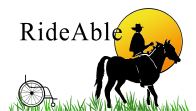It’s show day, and your horse is behaving terribly. Is anxiety to blame? Do horses feel anxiety? In this article we see some ideas to help calm our horse.
The beginning of a contest is usually a time of chaos. Even the most docile horse can become overwhelmed with anxiety and temporarily forget what he has to do. With several horses in an unfamiliar arena, plus their handlers (mostly excited and a bit anxious), the energy that fills the place can be frantic. So what can I do to help ease my equine companion’s anxiety?
Identify the cause and act
Temperament plays a large role in a horse’s anxiety level. Some horses are more hysterical than others and worry more. As animals of prey, horses can be stoic (instinctively hiding their stress and pain), while others wear their emotions on the surface. It is important to identify the source of a horse’s anxiety. Because it will give us information about the strategy to follow to manage it.
Research on the prevalence of gastric ulcers in horses has revealed how much stress and anxiety exists in horses of all ages. Common sources of anxiety include hidden pain, separation anxiety, unfamiliar surroundings, isolation, confusion. (When the horse does not understand what is being asked of it), or all of the above.
If I’ve learned one thing, it’s that pain is, in most cases, the root cause of many problems that can easily be masked as training issues. When we talk about relieving equine anxiety, we should eliminate stressors where we can and always rule out physical issues first.
A horse that shows obvious signs of anxiety and misbehaves is a very unhappy horse. The intervention will help teach the horse how to deal with his anxiety and can remind him how good it feels to relax and find calm.
Master the inner chaos
Treat the horse’s emotionality as a mental health issue, not a training issue. Criticizing, correcting, or applying more pressure to an anxious horse usually exacerbates his anxiety. Before any significant training or success can occur, the horse must return to a calm and reflective state of mind.
With practice, the horse learns calming signals and soon begins to seek that feeling of relaxation and security. Even for the most mercurial and nervous horse, this can become a reflex within a few training sessions, and he will learn to go to his “happy place” without directions from the handler.
reach out hands
The emotional state of a horse is closely linked to its posture. The level of the horse’s head is like a needle on a manometer. In other words, a horse with its head up, back arched and stiff is prepared for fight or flight. If his nose is close to the ground, his back rounded and his tail relaxed, he is completely calm and docile. Any change in elevation between those two extremes indicates that the horse is tensing up or relaxing. When I teach a horse to relax, my first goal is always to get him into a relaxed, nose-to-the-ground stance. By using light pressure from the bridle to the nape of the neck and then immediately releasing it when the head begins to drop, the horse will quickly learn a cue to lower the head. Then I tell her to take a deep breath doing it myself.
Horses will imitate each other’s posture and breathing. I exaggerate my body language and breathing to exude calm (rounded shoulders, low energy, wandering eyes, deep sighs). I will pet and calm the horse as he settles in, praising him and making sure he feels safe. Everything I ask the horse to do is easy and it feels good, so the horse responds quickly. Remember: no horse wants to feel anxious! Everything I ask the horse to do is easy and feels good, so the horse responds quickly. Remember: no horse wants to feel anxious! Everything I ask the horse to do is easy and feels good, so the horse responds quickly. Remember: no horse wants to feel anxious!
commitment and connection
Once the horse has returned to a calm state, it is time to occupy his mind. Give him simple cues, wait for the appropriate response, and then let go and praise him. This builds the horse’s confidence, eases his anxiety, and reminds him how good it feels to be flattered. Just like humans, when you praise a horse for a job well done, it will want more praise.
To engage the horse’s mind back to me, I’ll give the easiest commands I’m sure the horse knows: come, stop, turn right, turn left, slow down, speed up. All I want is for the horse to engage with me, to listen, think and respond as he is trained to. This almost always has a calming effect on the horse, as he begins to think and becomes comfortable doing what he knows how to do.
When your horse is anxious, this is not the time to ask him difficult things or teach him something new. It is time to remind the horse what he already knows how to do. And most importantly, I want to use this time to reestablish my connection with the horse.
With the correct techniques employed, eager horses can turn around quickly and dramatically, and perform at their best!
